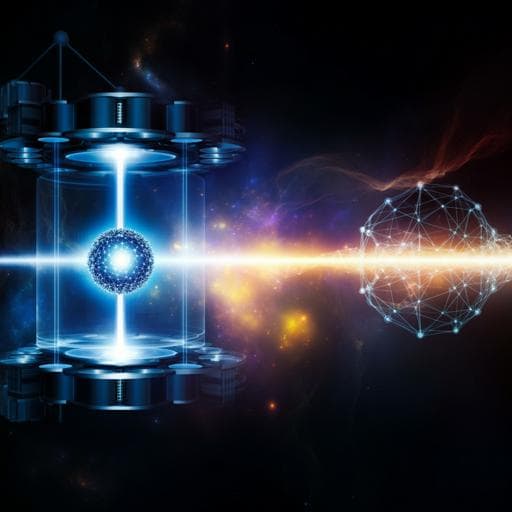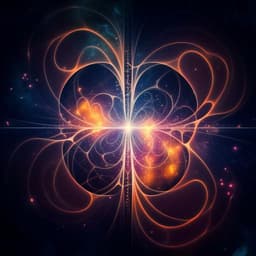
Physics
Deterministic spin-photon entanglement from a trapped ion in a fiber Fabry-Perot cavity
P. Kobel, M. Breyer, et al.
Discover groundbreaking research by Pascal Kobel, Moritz Breyer, and Michael Köhl on a quantum network node utilizing a trapped ion within a fiber-based Fabry-Perot cavity, achieving deterministically high-fidelity entanglement with an impressive rate of 62 Hz.
~3 min • Beginner • English
Introduction
The paper addresses how to realize efficient quantum network nodes that interface stationary qubits with traveling photonic qubits for applications in quantum computation, metrology, and secure communication. Key challenges for such nodes include long coherence times, efficient coupling between stationary and photonic qubits, and high-fidelity initialization, control, and readout. The authors target a fiber-based Fabry-Perot cavity platform to directly couple emitted photons into optical fibers while maintaining strong light-matter interaction via small mode volume. They aim to demonstrate deterministic spin-photon entanglement between a trapped 171Yb+ ion and a cavity-emitted photon, providing a robust light-matter interface suitable for quantum networking.
Literature Review
Prior experimental realizations of quantum network nodes employed trapped ions, neutral atoms, NV and SiV centers in diamond, and quantum dots, with photon collection either via high-NA optics or by embedding emitters in optical cavities to enhance coupling. Fiber Fabry-Perot cavities offer direct fiber coupling and strong coupling due to small mode volume, and have been interfaced with neutral atoms, trapped ions, NV centers, and quantum dots. However, prior to this work, entanglement between light and matter in a fiber Fabry-Perot cavity setting had not been demonstrated. The authors build on prior ion-cavity coupling efforts and Purcell enhancement studies, and on telecom frequency conversion results that enable long-distance networking.
Methodology
System: A single 171Yb+ ion is confined in a radiofrequency (Paul) needle trap embedded in a fiber Fabry-Perot cavity. Trap frequencies: ω_xy = 2π × 1.5 MHz, ω_z = 2π × 2.5 MHz. Cooling and detection use 370 nm light on the 2S1/2 ↔ 2P1/2 transition.
Cavity: Length 261 µm; finesse F = 4700 ± 700 at 370 nm; linewidth κ = 2π × (58 ± 9) MHz. Mirror transmissions T1 = 500 ppm, T2 = 100 ppm; estimated mirror loss L = 350 ± 100 ppm. Mode waist ω_cavity ≈ 4.1(2) µm. Theoretical cooperativity C_theo ≈ 1.9(4). Due to imperfect length lock and ion localization, effective cooperativity C0,eff ≈ 0.056(12). Effective coupling rate g_eff ≈ C0,eff κ ≈ 2π × (7.9 ± 1.0) MHz. Cavity decay time τ_cavity ≈ 1.3(2) ns. The cavity is length-stabilized by a side-of-fringe lock using a dim auxiliary laser; care is taken to avoid UV charging.
Initialization and excitation: The ion is optically pumped to |0⟩ = |2S1/2, F=0, mF=0⟩ with >99% fidelity within 10 µs. A pulsed excitation (τ_pulse = 134 ± 1 ps) from a frequency-doubled mode-locked Ti:sapphire laser drives |0⟩ → |e⟩ = |2P1/2, F′=1, mF=0⟩ with >95% fidelity (limited by polarization purity). A magnetic field of 603.6(7) mG is applied along the cavity axis to suppress ΔmF=0 emission; emission is into σ± circularly polarized cavity modes. Purcell enhancement yields excited-state lifetime τ = 7.4(2) ns (vs natural 8.12(2) ns), producing photon temporal FWHM ≈ 9.9(7) ns.
Entangled state generation: Spontaneous decay from |e⟩ populates |g+⟩ = |2S1/2, F=1, mF=+1⟩ and |g−⟩ = |2S1/2, F=1, mF=−1⟩, emitting a single σ± photon into the cavity. The ideal state is |ψ⟩ = (|g+⟩|V⟩ − |g−⟩|H⟩)/√2, where H/V denote linear polarization after appropriate waveplate rotations. Emission into the cavity mode occurs with probability Pc,eff ≈ 10.1 ± 1.9%.
Photon path and polarization analysis: Photons exit via single-mode fiber; polarization analysis uses a QWP+HWP to set the measurement basis, followed by PBS and two SPCs. The fiber’s polarization transformation is characterized with a weak reference laser and Jones calculus to determine optimal waveplate settings; bases σ_z (H/V), σ_x, and σ_y are selected accordingly.
Atomic state mapping and readout: Upon photon detection (within a 1 µs window after excitation), the atomic Zeeman qubit is mapped to hyperfine states using a microwave π-pulse from |g−⟩ to |0⟩ at ≈12.6 GHz (σ_z basis mapping), typically with >97% transfer fidelity. Readout uses hyperfine-state selective fluorescence on |2S1/2, F=1⟩ ↔ |2P1/2, F=0⟩ with a high-NA objective (NA=0.48). Discrimination fidelity between bright/dark states is 98.2(6)% for a 400 µs window; performance is limited by off-resonant scattering and coherent dark states at low B-fields. For rotated atomic bases, a subsequent π/2 pulse with relative phase Δφ = φ1 − φ2 sets the azimuthal readout axis.
Timing and phase control: Larmor precession at ω_L ≈ 1.690(2) MHz due to the magnetic field requires stable timing. Excitation is near-instantaneous; microwave pulses are synchronized to the laser’s cavity round-trip with <400 ps jitter, preserving a well-defined phase relation between atom and photon. Mixing both microwave pulses to the same detuned carrier maintains a fixed Δφ.
Detection efficiency and rates: Overall per-shot detection probability Pd,measured = 2.5 × 10⁻3, consistent with calculation P0,eff = Pc,eff × η_ext × η_mode × η_fiber × η_detector × η_path ≈ 3.2(9) × 10⁻3 using η_ext ≈ 0.53(6), η_fiber ≈ 0.44(3), η_detector = 0.215, η_path ≈ 0.65(11). Entanglement generation and detection rate is 62 s⁻1.
State verification: Correlation measurements are performed in σ_z and rotated σ_x/σ_y bases. Parity oscillations versus Δφ verify coherent phase relations. Full two-qubit quantum state tomography is performed over 16 Pauli settings; maximum likelihood estimation yields a physical 4×4 density matrix, enabling computation of fidelity and purity. Corrections and bounds are evaluated for SPC dark counts and unitary basis misalignments. Coherence times of the Zeeman and hyperfine qubits are measured via Ramsey sequences: 496 ± 42 µs (Zeeman |g⟩) and 1022 ± 121 µs (hyperfine |g⟩+|f⟩).
Key Findings
- Deterministic atom-photon entanglement between a single trapped 171Yb+ ion and a cavity-emitted photon with state fidelity F = 90.1 ± 1.7% (from full tomography).
- Lower bound on detection fidelity from correlations: F ≥ 89.8 ± 2.2%; after correcting for SPC dark counts, lower bound ≈ 90.7 ± 1.5%.
- Correlation contrasts: σ_z basis 90.7 ± 3.9%; rotated bases: σ_xσ_x 81 ± 16%, σ_yσ_y 87.0 ± 2.6%.
- State purity P = Tr(ρ²) = 83.0 ± 3.0%.
- Photon temporal width FWHM = 9.9 ± 0.7 ns, among the shortest cavity-extracted photons reported for atom-photon entanglement.
- Single-shot success probability for generation and detection: 2.5 × 10⁻3, yielding an entanglement rate of 62 s⁻1.
- Emission probability into cavity mode Pc,eff ≈ 10.1 ± 1.9%.
- Effective cooperativity C0,eff = 0.056 ± 0.012; effective coupling rate g_eff ≈ 2π × (7.9 ± 1.0) MHz; cavity decay time τ_cavity = 1.3 ± 0.2 ns.
- Qubit coherence times: Zeeman qubit 496 ± 42 µs; hyperfine qubit 1022 ± 121 µs.
- Identified fidelity-reducing contributions: atomic state detection (manipulation and discrimination), imperfect |e⟩ excitation (~1.8%), SPC dark counts (~1%), magnetic-field-induced dephasing (<1%), and timing jitter (<1%).
Discussion
The results demonstrate a high-fidelity, deterministic light-matter interface based on a trapped ion in a fiber Fabry-Perot cavity, directly compatible with fiber-based quantum networking. The compact cavity with small mode volume enhances emission into the cavity mode while providing intrinsic fiber coupling, simplifying integration with network components. Strong correlations in σ_z and coherent parity oscillations in σ_x and σ_y verify genuine entanglement with well-controlled phases, supported by precise microwave-photon timing synchronization. The short photon wavepackets (~10 ns) benefit impedance matching and high-rate operations, while per-shot success probability and measured rates indicate practical viability. Identified errors—primarily atomic readout and modest dark counts—are separable from the entanglement generation mechanism and can be mitigated with improved detection schemes, better ion localization, and enhanced cavity stabilization. The measured qubit coherence times exceed the sequence durations by orders of magnitude, ensuring stability during entanglement generation and verification. Overall, this work fills the gap of achieving spin-photon entanglement in a fiber-cavity architecture, advancing deployable quantum network nodes.
Conclusion
This work realizes a trapped-ion quantum network node using a fiber Fabry-Perot cavity and demonstrates deterministic spin-photon entanglement with 90.1 ± 1.7% fidelity, high correlation contrasts across multiple bases, short photon durations, and practical entanglement rates. The approach integrates strong light-matter coupling with direct fiber interfacing, addressing key requirements for scalable quantum networks. Future directions include: (1) increasing repetition rates toward the initialization-limited cycle time (~3.25 µs) to boost entanglement rates by an order of magnitude; (2) improving ion localization and cavity locking to approach theoretical cooperativity (C0 ≈ 1.9), potentially yielding another ~5× enhancement; (3) extending coherence by operating on the 171Yb+ clock transition via additional microwave pulses; and (4) integrating quantum frequency conversion to telecom wavelengths (e.g., 1314 nm or 1580 nm) for long-distance distribution, building on demonstrated UV–telecom conversion, and exploring interfacing with other emitters such as quantum dots.
Limitations
- Effective cooperativity is strongly reduced (C0,eff ≈ 0.056 vs theoretical ≈ 1.9) due to imperfect cavity length stabilization (mechanical resonances) and imperfect ion localization (residual micromotion), limiting emission probability and overall detection efficiency.
- Atomic state readout fidelity, affected by off-resonant scattering and coherent dark states at low magnetic fields, is a dominant source of infidelity (on the order of 8–11% depending on basis).
- Imperfect excitation to |e⟩ (~1.8%) and SPC dark counts (~1%) reduce measured fidelities; although mitigated by short post-selection windows, they remain nonzero.
- Magnetic field fluctuations (<0.7 mG) introduce phase noise and limit coherence, though their contribution during manipulation is <1%.
- Potential cavity birefringence can reduce overlap of H/V modes, impacting circularly polarized emission rates; careful fiber and waveplate calibration is required.
- Timing jitter constraints require synchronization to maintain a fixed phase relation relative to Larmor precession; any drift degrades correlations in rotated bases.
Related Publications
Explore these studies to deepen your understanding of the subject.







